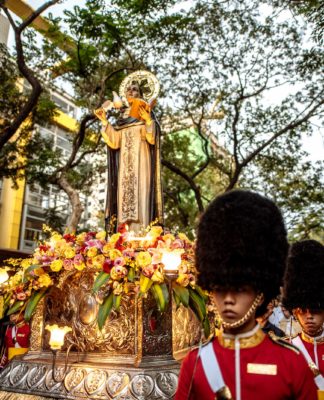EVEN in death, Manuel and Aurora Quezon have not reneged on the promise they made on their wedding day—to be together no matter what. Thanks to the efforts of their children and the National Historical Institute, they have remained true to their vow.
To mark her 56th death anniversary last April 28, the late first lady’s remains were re-interred beside the crypt of her husband, Commonwealth President Manuel L. Quezon, at the Quezon Memorial Shrine.
The interment mass was celebrated at Sto. Domingo Church, following a consensus of the Quezon family, affirming their time-tested ties with the Dominicans. Fr. Rolando Tirona, O.P., a long-time family friend, was the main celebrant.
A solemn but simple ceremony followed at the Quezon Memorial Park, where President Gloria Macapagal Arroyo handed the Philippine flag to Zenaida Avenceña, the former first couple’s last surviving child, after the ceremonial gun salute. Also in attendance were Senator Jamby Madrigal and Quezon City Mayor Sonny Belmonte.
Back together
Despite the hot and humid summer air, an unmistakable trace of happiness glowed from the faces of the Quezon family, knowing that the Quezon couple would finally rest together in peace.
“It’s what she wanted. Of course, we are very happy with it,” Manuel L. Quezon III told the Varsitarian.
“I am very happy now that she’s together again with my father,” Mrs. Avenceña,” said.
The re-interment was made possible by historian Ambeth Ocampo through the National Historical Institute (NHI).
“Presidents are not normally buried with their wives,” Ocampo said. “It was only at the time of Fidel Ramos when he issued an executive order. But even without that decree, I would have allowed this.”
Doña Aurora, who died at the hands of the Hukbalahap on April 28, 1949, was first buried at the North National Cemetery also beside her husband. But the remains of President Quezon, who died of tuberculosis on August 1, 1944 was later transferred to the shrine.
Since then, the family looked for ways of reuniting the couple, but circumstances stood in their way.
“We always wanted this but we were under Martial law so we didn’t think it was appropriate for the government to do anything at that time,” Quezon III said.
Mother of all
Aurora Aragon was born on Feb. 19, 1888 to Pedro Aragon and Zeneida Molina, in Baler, then in Tayabas Province. Although raised in a well-known clan, Doña Aurora’s childhood life was filled with trials. Her father, a suspected Katipunan member, was imprisoned by Spanish officials. After his release from Fort Santiago, the whole family took pains to stay away from socio-political affairs, and the prying eyes of the Spaniards.
In 1911, the young Aurora came to Manila to study in the Philippine Normal College, but her poor health kept her from finishing. In December 1918, she married her first cousin, Manuel Luis Quezon (Aurora’s mother and President Quezon’s mother, Ma. Dolores Molina, were sisters), in Hong Kong. Manuel was then president of the first Philippine Senate. They had four children: Maria Aurora, Maria Zeneida, Luisa Corazon Paz, and Manuel, Jr., all of whom studied in and graduated from UST. Manuel Luiz Quezon of course had been a student of the Dominicans through and through, first at the Colegio de San Juan de Letran and later, at UST.
Despite being the first lady, Aurora avoided the political scene as much as possible. While her husband busied himself with his political career, she manned the Quezon household and went through the activities without much fanfare. UST conferred on her Doctoris in Philosophia in Pedagogia (doctorate in Philosophy and Education), honoris causa, on March 16, 1940.
She also immersed herself in socio-civic organizations, co-founding the Girl Scouts of the Philippines and the Associacion de Damas de Filipinas. She actively helped in other civic organizations, notably the Philippine Tuberculosis Society, and was the first chairperson of the Philippine National Red Cross in 1947.
Doña Aurora also advocated the women’s suffrage and free public education for the poor.
But even with all the pressures of being the first lady, she never forgot her role as a mother.
“She was a wonderful mother, very understanding, and showered us with love,” Avenceña recalled fondly. “When we did something wrong, she never called our attention in front of others.”
Fatal attack
On April 28, 1949, Doña Aurora was on her way to Baler, Quezon to inaugurate a marker in honor of her late husband, when her party was suddenly ambushed by alleged members of the Hukbalahap. She was killed, along with daughter Maria Aurora, son-in-law Felipe Buencamino III, then Quezon City Mayor Ponciano Bernardo, and several others.
As Doña Aurora had close relations with the Huks, it was thought that a splinter group was responsible for the attack.
“In fact, during the Huk rebellion, she made sure that the rebels had access to medical care,” Manuel Quezon III said.
The Quezon family eventually became less and less interested in who did the attack.
Legacy
Today, Doña Aurora’s memory continues to live through various structures as reminders, from the well-used Aurora Boulevard in Quezon City, to her very own marker and statue at the Quezon Provincial Capitol in Baler and another one in Barangay Labi (Bongabon) Nueva Ecija. She has three provinces named after her.
But Doña Aurora’s legacy goes beyond the prominence of her name. Her societal contributions and efforts to elevate the status of Filipino women, uphold the dignity of children, and treat each countryman fairly, cannot be contained by any carved stone or marker.
Her re-interment, however, proves one other thing, perhaps the greatest achievement of the former first couple. And that is despite all their trials, they have stayed together, now even beside each other’s tombs. Doña Aurora, despite her own greatness, wanted only the simple happiness of being by her husband’s side—proof of a love so overflowing she could not help but share it through service to her countrymen.

















